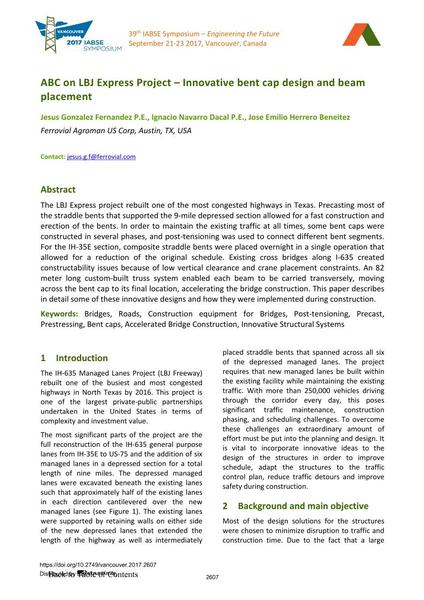ABC on LBJ Express Project – Innovative bent cap design and beam placement

|
|
|||||||||||
Bibliografische Angaben
| Autor(en): |
Jesús González Fernández
(Ferrovial Agroman US Corp, Austin, TX, USA)
Ignacio Navarro Dacal (Ferrovial Agroman US Corp, Austin, TX, USA) José Emilio Herrero Beneitez (Ferrovial Agroman US Corp, Austin, TX, USA) |
||||
|---|---|---|---|---|---|
| Medium: | Tagungsbeitrag | ||||
| Sprache(n): | Englisch | ||||
| Tagung: | IABSE Symposium: Engineering the Future, Vancouver, Canada, 21-23 September 2017 | ||||
| Veröffentlicht in: | IABSE Symposium Vancouver 2017 | ||||
|
|||||
| Seite(n): | 2607-2614 | ||||
| Anzahl der Seiten (im PDF): | 8 | ||||
| Jahr: | 2017 | ||||
| DOI: | 10.2749/vancouver.2017.2607 | ||||
| Abstrakt: |
The LBJ Express project rebuilt one of the most congested highways in Texas. Precasting most of the straddle bents that supported the 9-mile depressed section allowed for a fast construction and erection of the bents. In order to maintain the existing traffic at all times, some bent caps were constructed in several phases, and post-tensioning was used to connect different bent segments. For the IH-35E section, composite straddle bents were placed overnight in a single operation that allowed for a reduction of the original schedule. Existing cross bridges along I-635 created constructability issues because of low vertical clearance and crane placement constraints. An 82 meter long custom-built truss system enabled each beam to be carried transversely, moving across the bent cap to its final location, accelerating the bridge construction. This paper describes in detail some of these innovative designs and how they were implemented during construction. |
||||
| Stichwörter: |
Brücken Vorspannung
|
||||
